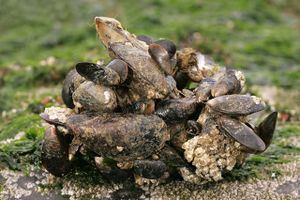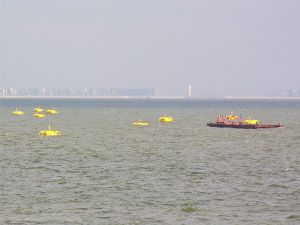Heavy metal content of mussels in the Western Scheldt estuary
Since 1987, the Eastern Scheldt estuary has been blocked by dams (the DeltaWorks project) to create a barrier against flooding. Because of this blockade, the Eastern Scheldt changed from an estuary into a protected marine bay. Input of chemical contaminants from land decreased drastically, although heavy metals might still persist in the soils. The adjacent Western Scheldt drains through the most populated and industrial regions of Belgium, The Netherlands and France, making it one most polluted rivers of Europe and one of the major sources of heavy metals in the North Sea. [1]
Content of the study
The study aimed to compare the heavy metal content of mussels (collected in 2002) in the Eastern Scheldt bay with those in the Western Scheldt estuary. This way they assessed whether heavy metal levels have indeed gone down in the Eastern Scheldt. The mussels were sampled in a land to sea gradient, which in the Western Scheldt coincided with a gradient of salinity and pollution.
Main results of the study
Surprisingly, for most metals, concentrations in mussels the Eastern Scheldt bay were equally high as those in the Western Scheldt estuary. Concentrations were: arsenicum: 7 - 20 µg/g, cobalt: 0.8 - 2.2 µg/g, copper: 5 - 22 µg/g, manganese: 5 - 20 µg/g, lead: 2 - 6.1 µg/g, cadmium 1 - 1.8 µg/g, chrome: 1 - 2 µg/g, iron: 70 - 200 µg/g, nickel: 0.5 - 5 µg/g, zinc: 50 - 150 µg/g (al in µg metal/ g mussel, wet weight). Heavy metal concentrations in mussels showed both in the Western Scheldt estuary as in the Eastern Scheldt bay a decreasing trend towards the sea.
The relatively low concentrations (compared to the Eastern Scheldt) in the Western Scheldt might be related to recent Belgian measures to improve the water quality. The high concentrations in the Eastern Scheldt were unexpected since water pollution has been drastically reduced. Presumably metals stored in the soil became again available for uptake by mussels. Changing conditions can cause soil particles and associated metals to resuspend, and be taken up by mussels. When analyzing heavy metal concentrations in the soil, it was shown that although the total levels of heavy metals were higher in the Western Scheldt, the level of heavy metals in the sediments available for uptake by mussels was higher in the Eastern Scheldt.
The study concluded that the uptake and accumulation of heavy metals don't only depend on the total environmental pollution, but can by affected by lots of other factors. Therefore, residual pollution can have a long term effect on biota, even long after implementation of measures to reduce it.[1]
References
Please note that others may also have edited the contents of this article.
|

